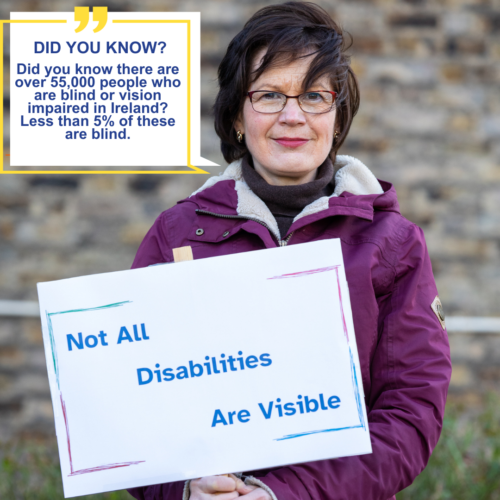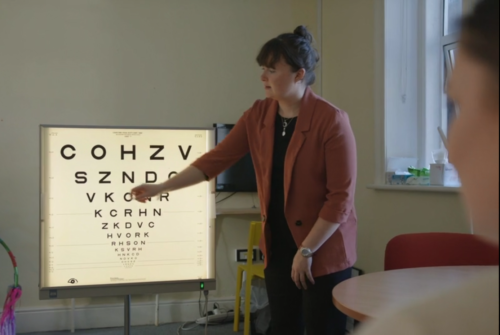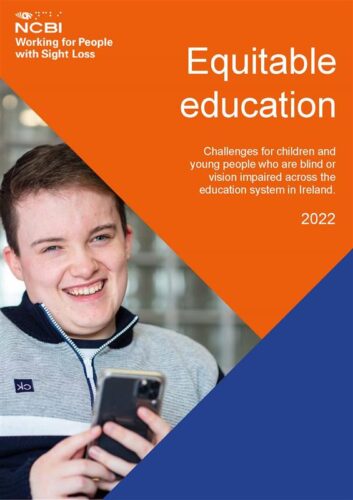Number of people with vision impairment in Ireland

Census 2016 shows there are 54,810 people in Ireland who are blind or vision impaired and the number is rising as the population ages. When that figure is first presented to people, usually the automatic assumption is that the majority of those nearly 55,000 people are blind, but that is not the case. Of the 55,000 people in Ireland who are blind or vision impaired, just 5% or approximately 2,750 of those are blind.
This means that approximately 52,250 people across the country have a form of vision impairment or are affected by sight loss in some way. The impact of vision impairment varies from person to person. Some people may be able to continue their lives as normal with their residual vision, while other people will require training, support and more to adapt to losing significant aspects of their vision.
What is the leading cause of sight loss in Ireland?
One aspect of vision impairment that is often misunderstood, or not understood at all, by people who haven’t experienced sight loss, is that not all vision impairment affects a person’s sight in the same way.
There are many different types of eye conditions that lead to vision impairment and each of those conditions affects a person’s field of vision in different ways. Residual vision can be further impacted by outside influences, including lighting.
Age-related macular degeneration (AMD) is the leading cause of sight loss in Ireland for people over the age of 50. There are two forms of AMD – dry AMD and wet AMD and both cause progressive sight loss.
There are a number of symptoms of AMD that affect vision, including distortion, where straight lines appear wavy. As the condition progresses, it can lead to the loss of a person’s central vision, leaving only peripheral vision available.
The symptoms and type of sight loss for a person with AMD are completely different to the symptoms and type of sight loss experienced by a person who has Glaucoma, for example.
Learn more about AMD and sight loss in the Vision Series
Waiting lists for eye appointments

A large number of people are currently waiting for outpatient ophthalmic services. Figures from August 2022 from the National Treatment Purchase Fund (NTPF) data recorded that 46,310 adults were people were on waiting lists for ophthalmic services – 37,449 of those were waiting on outpatient appointments and 8,861 of those were waiting on inpatient/day case appointments. There were also 6,126 children on waiting lists for ophthalmic service – 5,508 were waiting on outpatient appointments and 618 were inpatient/day case appointments. This means that in August 2022, there was a total of 52,436 people on waiting lists for ophthalmic services.
In a bid to cut down the number of people on waiting lists and the wait time for appointments, Vision Ireland has been continually campaigning for increased recruitment across the ophthalmology sector in Ireland. There is a shortage in the number of consultants in this field in Ireland, which is leading to waiting list issues. With such long delays for appointments, diagnosis and treatment, adults and children who are experiencing sight loss run the risk of longer-term and potentially irreversible damage to their sight.
If you have been recently diagnosed learn more about Vision Ireland
Employment

Maintaining and maximizing a person’s independence is central to all Vision Ireland’s services and ensuring their active participation, retention or return to the labour market is a
crucial part of this. Being in employment or self-employment boosts financial independence, mental health and social interactions.
The Census shows the level of labour force participation amongst people who are blind or vision impaired in Ireland is only 24.4%. This figure means less than 1 in 4 people with impaired vision are currently actively participating in the labour force. People with vision impairment have a 60% less chance of being in employment than the general population.
More information on our employment services
Education

Vision Ireland has a dedicated service for children and young people with vision loss that works to reduce the impact of vision loss on early development, learning and independence skills. Census 2016 figures show that since 2011, there has been a 20% increase in the number of children with vision impairment, which equates to 4,701 children of school-going age. An increasing number of children and their families are supported by Vision Ireland each year, including 1,225 supported in 2021. This trend highlights the need for a more structured and equipped educational system, which is well-positioned to support children and young adults to fulfil their potential across our educational systems.
Evidence from AHEAD show the extremely low representation of students who are blind or vision impaired in third level which has been reducing over the past number of years from 1.8% in 2015/2016 to 1.6% in 2019/2022. On paper, Disability Access Route to Education (DARE) should be improving access to tertiary education for young people with a vision impairment but in practice, it is not achieving that goal.
Vision Ireland recently released our Equitable Education report which focuses on strategic developments required to support children and young people who are blind or vision impaired to become independent active agents in their futures.
Read more about the Equitable Education Report
Debunking Sight Loss Myths
It’s important that we have all the facts when we talk about sight loss, but it is also important that we work to dispel any age-old myths about sight loss that may be damaging or disrespectful to people who are blind or vision impaired.
Vision Ireland recently launched an online campaign called Debunking Sight Loss Myths, where we challenged perceptions that some people may have about sight loss. This campaign consisted of six dedicated blog posts and six dedicated posts and advertising across Vision Ireland’s social media channels. The campaign was targeted toward people who may not ordinarily be engaged with or who may not know about the work that Vision Ireland does with the sight loss community.
If you wish to check back on all six parts of the series you can do so:
- Debunking Sight Loss Myths – Part One – True or False?
- Debunking Sight Loss Myths – Part Two – Reading
- Debunking Sight Loss Myths – Part Three – Engaging with a person who is blind or vision impaired
- Debunking Sight Loss Myths – Part four – White canes
- Debunking Sight Loss Myths – Part five – How different eye conditions affect people
- Debunking Sight Loss Myths – Part six – Did you know?